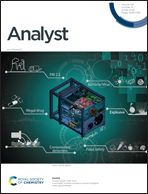Target triggered ultrasensitive electrochemical polychlorinated biphenyl aptasensor based on DNA microcapsules and nonlinear hybridization chain reaction†
Abstract
In this work, we demonstrated an ultrasensitive detection platform for polychlorinated biphenyls (PCBs) based on DNA microcapsules and a nonlinear hybridization chain reaction (NHCR). In the process, first, electrochemical signal molecules (Methylene Blue, MB) were sealed in the prepared DNA microcapsules. In the presence of PCB-72, DNA microcapsules could be dissociated with the conjugation of the aptamer and target, and meanwhile, the released DNA strand could initiate the NHCR and trigger the chain branching growth of DNA dendrimers. Because the released MBs were intercalated into the DNA dendrimer, enhanced electrochemical responses could be detected. This method exhibited ultrahigh sensitivity to PCB-72 with a detection limit of 0.001 ng mL−1. Furthermore, the present aptasensor was also capable of discriminating different PCB congeners. Therefore, the devised label-free and enzyme-free amplification electrochemical aptasensor strategy has great potential for the detection of PCB-72 in real samples, and this strategy may also become an attractive alternative for sensitive and selective small molecule, protein, nucleic acid and nuclease activity detection.



 Please wait while we load your content...
Please wait while we load your content...